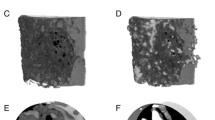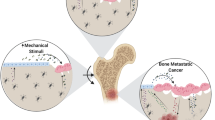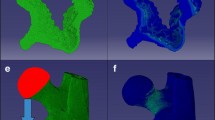Abstract
We evaluated whether whole-body vibration (WBV) prevented bone loss induced by breast cancer (BC) metastasis and the involvement of bone marrow vasculature. One day after orthotopic transplantation of mammary 4T1 tumor cells, 8-week-old BALB/c mice were subjected to 0.3 g/90 Hz vertical vibration for 20 min/day for 5 days/week (BC-WBV) or sham-handled (BC-Sham) over 3 weeks. Age-matched intact mice (Intact) were also sham-handled. Both tibiae were harvested from BC-WBV (n = 7), BC-Sham (n = 9), and Intact (n = 5) mice for bone structure imaging by synchrotron radiation-based computed tomography (SRCT) and hematoxylin and eosin staining, whereas right tibiae were harvested from other BC-WBV and BC-Sham (n = 6 each) mice for vascular imaging by SRCT. Tumor cells were similarly widespread in the marrow in BC-WBV and BC-Sham mice. In BC-Sham mice, cortical bone volume, trabecular volume fraction, trabecular thickness, trabecular number density, and bone mineral density were smaller, and marrow volume and trabecular separation were larger than in Intact mice. However, although trabecular thickness was smaller in BC-WBV than Intact mice, the others did not differ between the two groups. Serum osteocalcin tended to be higher in BC-WBV than BC-Sham mice. Compared with BC-Sham mice, BC-WBV mice had a smaller vessel diameter, a trend of a larger vessel number density, and smaller vessel diameter heterogeneity. In conclusion, WBV mitigates bone loss in BC bone metastasis, which may be partly due to increased bone anabolism. The alteration of marrow vasculature appears to be favorable for anti-tumor drug delivery. Further studies are needed to clarify the multiple actions of WBV on bone, tumor, and marrow vasculature and how they contribute to bone protection in BC metastasis.





Similar content being viewed by others
References
Bray F, Ferlay J, Soerjomataram I, Siegel RL, Torre LA, Jemal A (2018) Global cancer statistics 2018: GLOBOCAN estimates of incidence and mortality worldwide for 36 cancers in 185 countries. CA Cancer J Clin 68:394–424. https://doi.org/10.3322/caac.21492
Cardoso F, Spence D, Mertz S, Corneliussen-James D, Sabelko K, Gralow J, Cardoso MJ et al (2018) Global analysis of advanced/metastatic breast cancer: decade report (2005–2015). Breast 39:131–138. https://doi.org/10.1016/j.breast.2018.03.002
Chen YC, Sosnoski DM, Mastro AM (2010) Breast cancer metastasis to the bone: mechanisms of bone loss. Breast Cancer Res 12:215. https://doi.org/10.1186/bcr2781
Weilbaecher KN, Guise TA, McCauley LK (2011) Cancer to bone: a fatal attraction. Nat Rev Cancer 11:411–425. https://doi.org/10.1038/nrc3055
Ryan C, Stoltzfus KC, Horn S, Chen H, Louie AV, Lehrer EJ, Trifiletti DM et al (2020) Epidemiology of bone metastases. Bone 158:115783. https://doi.org/10.1016/j.bone.2020.115783
Oster G, Lamerato L, Glass AG, Richert-Boe KE, Lopez A, Chung K, Richhariya A et al (2013) Natural history of skeletal-related events in patients with breast, lung, or prostate cancer and metastases to bone: a 15-year study in two large US health systems. Support Care Cancer 21:3279–3286. https://doi.org/10.1007/s00520-013-1887-3
Jara MA, Varghese J, Hu MI (2021) Adverse events associated with bone-directed therapies in patients with cancer. Bone 158:115901. https://doi.org/10.1016/j.bone.2021.115901
Hong AR, Kim SW (2018) Effects of resistance exercise on bone health. Endocrinol Metab 33:435–444. https://doi.org/10.3803/EnM.2018.33.4.435
Zhang S, Huang X, Zhao X, Li B, Cai Y, Liang X, Wan Q (2021) Effect of exercise on bone mineral density among patients with osteoporosis and osteopenia: a systematic review and network meta-analysis. J Clin Nurs. https://doi.org/10.1111/jocn.16101
Fornusek CP, Kilbreath SL (2017) Exercise for improving bone health in women treated for stages I-III breast cancer: a systematic review and meta-analyses. J Cancer Surviv 11:525–541. https://doi.org/10.1007/s11764-017-0622-3
Singh B, Toohey K (2022) The effect of exercise for improving bone health in cancer survivors—a systematic review and meta-analysis. J Sci Med Sport 25:31–40. https://doi.org/10.1016/j.jsams.2021.08.008
Fan Y, Jalali A, Chen A, Zhao X, Liu S, Teli M, Guo Y et al (2020) Skeletal loading regulates breast cancer-associated osteolysis in a loading intensity-dependent fashion. Bone Res 8:9. https://doi.org/10.1038/s41413-020-0083-6
Wang S, Pei S, Wasi M, Parajuli A, Yee A, You L, Wang L (2021) Moderate tibial loading and treadmill running, but not overloading, protect adult murine bone from destruction by metastasized breast cancer. Bone 153:116100. https://doi.org/10.1016/j.bone.2021.116100
Husebø AM, Dyrstad SM, Søreide JA, Bru E (2013) Predicting exercise adherence in cancer patients and survivors: a systematic review and meta-analysis of motivational and behavioural factors. J Clin Nurs 22:4–21. https://doi.org/10.1111/j.1365-2702.2012.04322.x
Rubin C, Turner AS, Bain S, Mallinckrodt C, McLeod K (2001) Anabolism. Low mechanical signals strengthen long bones. Nature 412:603–604. https://doi.org/10.1038/35088122
Fritton SP, McLeod KJ, Rubin CT (2000) Quantifying the strain history of bone: spatial uniformity and self-similarity of low-magnitude strains. J Biomech 33:317–325. https://doi.org/10.1016/S0021-9290(99)00210-9
Huang RP, Rubin CT, McLeod KJ (1999) Changes in postural muscle dynamics as a function of age. J Gerontol A Biol Sci Med Sci 54:B352–B357. https://doi.org/10.1093/gerona/54.8.B352
Mogil RJ, Kaste SC, Ferry RJ Jr, Hudson MM, Mulrooney DA, Howell CR, Partin RE et al (2016) Effect of low-magnitude, high-frequency mechanical stimulation on BMD among young childhood cancer survivors: a randomized clinical trial. JAMA Oncol 2:908–914. https://doi.org/10.1001/jamaoncol.2015.6557
Baker MK, Peddle-McIntyre CJ, Galvão DA, Hunt C, Spry N, Newton RU (2018) Whole body vibration exposure on markers of bone turnover, body composition, and physical functioning in breast cancer patients receiving aromatase inhibitor therapy: a randomized controlled trial. Integr Cancer Ther 17:968–978. https://doi.org/10.1177/1534735418781489
Pagnotti GM, Adler BJ, Green DE, Chan ME, Frechette DM, Shroyer KR, Beamer WG et al (2012) Low magnitude mechanical signals mitigate osteopenia without compromising longevity in an aged murine model of spontaneous granulosa cell ovarian cancer. Bone 51:570–577. https://doi.org/10.1016/j.bone.2012.05.004
Pagnotti GM, Chan ME, Adler BJ, Shroyer KR, Rubin J, Bain SD, Rubin CT (2016) Low intensity vibration mitigates tumor progression and protects bone quantity and quality in a murine model of myeloma. Bone 90:69–79. https://doi.org/10.1016/j.bone.2016.05.014
Goel S, Duda DG, Xu L, Munn LL, Boucher Y, Fukumura D, Jain RK (2011) Normalization of the vasculature for treatment of cancer and other diseases. Physiol Rev 91:1071–1121. https://doi.org/10.1152/physrev.00038.2010
Lugano R, Ramachandran M, Dimberg A (2020) Tumor angiogenesis: causes, consequences, challenges and opportunities. Cell Mol Life Sci 77:1745–1770. https://doi.org/10.1007/s00018-019-03351-7
Matsumoto T, Itamochi S, Hashimoto Y (2016) Effect of concurrent use of whole-body vibration and parathyroid hormone on bone structure and material properties of ovariectomized mice. Calcif Tissue Int 98:520–529. https://doi.org/10.1007/s00223-015-0104-4
Matsumoto T, Goto D, Sato S (2013) Subtraction micro-computed tomography of angiogenesis and osteogenesis during bone repair using synchrotron radiation with a novel contrast agent. Lab Invest 93:1054–1063. https://doi.org/10.1038/labinvest.2013.87
Doube M, Kłosowski MM, Arganda-Carreras I, Cordelières FP, Dougherty RP, Jackson JS, Schmid B et al (2010) BoneJ: free and extensible bone image analysis in ImageJ. Bone 47:1076–1079. https://doi.org/10.1016/j.bone.2010.08.023
Birks S, Uzer G (2021) At the nuclear envelope of bone mechanobiology. Bone 151:116023. https://doi.org/10.1016/j.bone.2021.116023
Uzer G, Thompson WR, Sen B, Xie Z, Yen SS, Miller S, Bas G et al (2015) Cell mechanosensitivity to extremely low-magnitude signals is enabled by a LINCed nucleus. Stem Cells 33:2063–2076. https://doi.org/10.1002/stem.2004
Robinson JA, Chatterjee-Kishore M, Yaworsky PJ, Cullen DM, Zhao W, Li C, Kharode Y et al (2006) Wnt/beta-catenin signaling is a normal physiological response to mechanical loading in bone. J Biol Chem 281:31720–31728. https://doi.org/10.1016/S0021-9258(19)84086-3
Gao H, Zhai M, Wang P, Zhang X, Cai J, Chen X, Shen G et al (2017) Low-level mechanical vibration enhances osteoblastogenesis via a canonical Wnt signaling-associated mechanism. Mol Med Rep 16:317–324. https://doi.org/10.3892/mmr.2017.6608
Lu Y, Zhao Q, Liu Y, Zhang L, Li D, Zhu Z, Gan X et al (2018) Vibration loading promotes osteogenic differentiation of bone marrow-derived mesenchymal stem cells via p38 MAPK signaling pathway. J Biomech 71:67–75. https://doi.org/10.1016/j.jbiomech.2018.01.039
Minematsu A, Nishii Y, Imagita H, Takeshita D, Sakata S (2016) Whole-body vibration can attenuate the deterioration of bone mass and trabecular bone microstructure in rats with spinal cord injury. Spinal Cord 54:597–603. https://doi.org/10.1038/sc.2015.220
Jing D, Luo E, Cai J, Tong S, Zhai M, Shen G, Wang X et al (2016) Mechanical vibration mitigates the decrease of bone quantity and bone quality of leptin receptor-deficient db/db mice by promoting bone formation and inhibiting bone resorption. J Bone Miner Res 31:1713–1724. https://doi.org/10.1002/jbmr.2837
Zhou Y, Guan X, Liu T, Wang X, Yu M, Yang G, Wang H (2015) Whole body vibration improves osseointegration by up-regulating osteoblastic activity but down-regulating osteoblast-mediated osteoclastogenesis via ERK1/2 pathway. Bone 71:17–24. https://doi.org/10.1016/j.bone.2014.09.026
Zhou Y, Guan X, Zhu Z, Gao S, Zhang C, Li C, Zhou K et al (2011) Osteogenic differentiation of bone marrow-derived mesenchymal stromal cells on bone-derived scaffolds: effect of microvibration and role of ERK1/2 activation. Eur Cell Mater 22:12–25. https://doi.org/10.22203/ecm.v022a02
Lau E, Al-Dujaili S, Guenther A, Liu D, Wang L, You L (2010) Effect of low-magnitude, high-frequency vibration on osteocytes in the regulation of osteoclasts. Bone 46:1508–1515. https://doi.org/10.1016/j.bone.2010.02.031
Wu SH, Zhong ZM, Chen JT (2012) Low-magnitude high-frequency vibration inhibits RANKL-induced osteoclast differentiation of RAW264.7 cells. Int J Med Sci 9:801–807
Olcum M, Ozcivici E (2014) Daily application of low magnitude mechanical stimulus inhibits the growth of MDA-MB-231 breast cancer cells in vitro. Cancer Cell Int 14:102. https://doi.org/10.1186/s12935-014-0102-z
Yi X, Wright LE, Pagnotti GM, Uzer G, Powell KM, Wallace JM, Sankar U et al (2020) Mechanical suppression of breast cancer cell invasion and paracrine signaling to osteoclasts requires nucleo-cytoskeletal connectivity. Bone Res 8:40. https://doi.org/10.1038/s41413-020-00111-3
Fuhrhop I, Schroeder M, Rafnsdóttir SL, Viezens L, Rüther W, Hansen-Algenstaedt N, Schaefer C (2010) Dynamics of microvascular remodelling during tumor growth in bone. J Orthop Res 28:27–31. https://doi.org/10.1002/jor.20968
Nyangoga H, Mercier P, Libouban H, Baslé MF, Chappard D (2011) Three-dimensional characterization of the vascular bed in bone metastasis of the rat by microcomputed tomography (MicroCT). PLoS ONE 6:e17336. https://doi.org/10.1371/journal.pone.0017336
Grimes DR, Kannan P, Warren DR, Markelc B, Bates R, Muschel R, Partridge M (2016) Estimating oxygen distribution from vasculature in three dimensional tumor tissue. J R Soc Interface 13:20160070. https://doi.org/10.1098/rsif.2016.0070
Bernabeu MO, Köry J, Grogan JA, Markelc B, Beardo A, d’Avezac M, Enjalbert R et al (2020) Abnormal morphology biases hematocrit distribution in tumor vasculature and contributes to heterogeneity in tissue oxygenation. Proc Natl Acad Sci USA 117:27811–27819. https://doi.org/10.1073/pnas.2007770117
Padera TP, Stoll BR, Tooredman JB, Capen D, di Tomaso E, Jain RK (2004) Cancer cells compress intratumour vessels. Nature 427:695. https://doi.org/10.1038/427695a
Bertout JA, Patel SA, Simon MC (2008) The impact of O2 availability on human cancer. Nat Rev Canc 8:967–975. https://doi.org/10.1038/nrc2540
Ribatti D, Annese T, Ruggieri S, Tamma R, Crivellato E (2019) Limitations of anti-angiogenic treatment of tumors. Transl Oncol 12:981–986. https://doi.org/10.1016/j.tranon.2019.04.022
Liu S, Wu D, Sun X, Fan Y, Zha R, Jalali A, Teli M et al (2020) Mechanical stimulations can inhibit local and remote tumor progression by downregulating WISP1. FASEB J 34:12847–12859. https://doi.org/10.1096/fj.202000713RR
Wallace IJ, Pagnotti GM, Rubin-Sigler J, Naeher M, Copes LE, Judex S, Rubin CT et al (2015) Focal enhancement of the skeleton to exercise correlates with responsivity of bone marrow mesenchymal stem cells rather than peak external forces. J Exp Biol 218:3002–3009. https://doi.org/10.1242/jeb.118729
Christiansen BA, Silva MJ (2006) The effect of varying magnitudes of whole-body vibration on several skeletal sites in mice. Ann Biomed Eng 34:1149–1156. https://doi.org/10.1007/s10439-006-9133-5
Gao J, Gong H, Huang X, Zhang R, Ma R, Zhu D (2016) Multi-level assessment of fracture calluses in rats subjected to low-magnitude high-frequency vibration with different rest periods. Ann Biomed Eng 44:2489–2504. https://doi.org/10.1007/s10439-015-1532-z
Acknowledgements
The authors are indebted to Shinya Itamochi (Osaka University Graduate School of Engineering Science) for his assistance with animal experiments and SRCT imaging and to Dr. Takashi Fukushima (Saitama Medical University International Medical Center) for his help in the interpretation of the histological data. We would also like to thank Mitchell Arico from Edanz (https://jp.edanz.com/ac) for editing the draft of this manuscript.
Funding
A part of this study was supported by Japan Society for the Promotion of Science Grant-in-Aid for Scientific Research (Grant Nos. 26282120, 15K12509, and 20K21899).
Author information
Authors and Affiliations
Corresponding author
Ethics declarations
Conflict of interest
Takeshi Matsumoto and Akihiro Mukohara declare that they have no conflict of interest.
Ethical Approval
All animal experiments were approved by the Ethics Committee on Animal Experiments of Tokushima University.
Human and Animal Rights and Informed Consent statement
All animals involved in the study were cared for in accordance with the Declaration of Helsinki. The protocol of animal treatment was in accordance with the guiding principles of the Care and Use of Laboratory Animals of Tokushima University. No human studies were performed in the course of the experiments.
Additional information
Publisher's Note
Springer Nature remains neutral with regard to jurisdictional claims in published maps and institutional affiliations.
Rights and permissions
Springer Nature or its licensor holds exclusive rights to this article under a publishing agreement with the author(s) or other rightsholder(s); author self-archiving of the accepted manuscript version of this article is solely governed by the terms of such publishing agreement and applicable law.
About this article
Cite this article
Matsumoto, T., Mukohara, A. Effects of Whole-Body Vibration on Breast Cancer Bone Metastasis and Vascularization in Mice. Calcif Tissue Int 111, 535–545 (2022). https://doi.org/10.1007/s00223-022-01009-4
Received:
Accepted:
Published:
Issue Date:
DOI: https://doi.org/10.1007/s00223-022-01009-4




